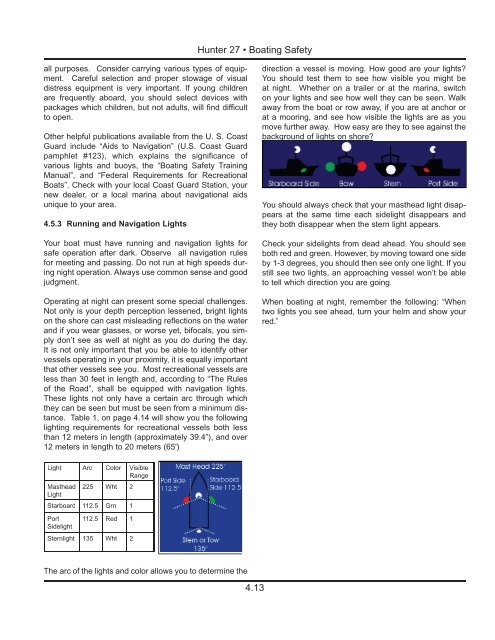27 Operator's Manual.. - Marlow-Hunter, LLC
27 Operator's Manual.. - Marlow-Hunter, LLC
27 Operator's Manual.. - Marlow-Hunter, LLC
You also want an ePaper? Increase the reach of your titles
YUMPU automatically turns print PDFs into web optimized ePapers that Google loves.
<strong>Hunter</strong> <strong>27</strong> • Boating Safety<br />
all purposes. Consider carrying various types of equipment.<br />
Careful selection and proper stowage of visual<br />
distress equipment is very important. If young children<br />
are frequently aboard, you should select devices with<br />
packages which children, but not adults, will find difficult<br />
to open.<br />
Other helpful publications available from the U. S. Coast<br />
Guard include “Aids to Navigation” (U.S. Coast Guard<br />
pamphlet #123), which explains the significance of<br />
various lights and buoys, the “Boating Safety Training<br />
<strong>Manual</strong>”, and “Federal Requirements for Recreational<br />
Boats”. Check with your local Coast Guard Station, your<br />
new dealer, or a local marina about navigational aids<br />
unique to your area.<br />
4.5.3 Running and Navigation Lights<br />
Your boat must have running and navigation lights for<br />
safe operation after dark. Observe all navigation rules<br />
for meeting and passing. Do not run at high speeds during<br />
night operation. Always use common sense and good<br />
judgment.<br />
Operating at night can present some special challenges.<br />
Not only is your depth perception lessened, bright lights<br />
on the shore can cast misleading reflections on the water<br />
and if you wear glasses, or worse yet, bifocals, you simply<br />
don’t see as well at night as you do during the day.<br />
It is not only important that you be able to identify other<br />
vessels operating in your proximity, it is equally important<br />
that other vessels see you. Most recreational vessels are<br />
less than 30 feet in length and, according to “The Rules<br />
of the Road”, shall be equipped with navigation lights.<br />
These lights not only have a certain arc through which<br />
they can be seen but must be seen from a minimum distance.<br />
Table 1, on page 4.14 will show you the following<br />
lighting requirements for recreational vessels both less<br />
than 12 meters in length (approximately 39.4”), and over<br />
12 meters in length to 20 meters (65')<br />
direction a vessel is moving. How good are your lights?<br />
You should test them to see how visible you might be<br />
at night. Whether on a trailer or at the marina, switch<br />
on your lights and see how well they can be seen. Walk<br />
away from the boat or row away, if you are at anchor or<br />
at a mooring, and see how visible the lights are as you<br />
move further away. How easy are they to see against the<br />
background of lights on shore?<br />
You should always check that your masthead light disappears<br />
at the same time each sidelight disappears and<br />
they both disappear when the stern light appears.<br />
Check your sidelights from dead ahead. You should see<br />
both red and green. However, by moving toward one side<br />
by 1-3 degrees, you should then see only one light. If you<br />
still see two lights, an approaching vessel won’t be able<br />
to tell which direction you are going.<br />
When boating at night, remember the following: “When<br />
two lights you see ahead, turn your helm and show your<br />
red.”<br />
Light Arc Color Visible<br />
Range<br />
Masthead 225 Wht 2<br />
Light<br />
Starboard 112.5 Grn 1<br />
Port<br />
Sidelight<br />
112.5 Red 1<br />
Sternlight 135 Wht 2<br />
The arc of the lights and color allows you to determine the<br />
4.13

















